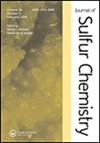Recent developments in the greener approaches for the dithioacetalization of carbonyl compounds
IF 2.1
3区 化学
Q3 CHEMISTRY, MULTIDISCIPLINARY
引用次数: 0
Abstract
The protection of carbonyl functional groups via dithioacetalization with thiols or dithiols plays a significant role in multi-step organic syntheses, such as natural products and drug synthesis. Therefore, dithioacetalization has always been cherished as one of the most important organic transformations in both academic and industrial research. Numerous synthetic strategies for the dithioacetalization of carbonyl compounds have been reported in the literature for the synthesis of industrially valuable organosulfur compounds or precursors like acyclic dithioacetals, dithiolanes, and dithianes. Regardless of having many conventional efficient synthetic protocols, greener approaches have been recognized as a viable alternative due to environmental and health concerns. Consequently, the growing trend of developing greener methods stimulated by the green chemistry concept for dithioacetalization is inevitable. The present review is aimed to highlight the recent advances in the greener and convenient synthetic approaches employed for the dithioacetalization of carbonyl compounds.
羰基化合物二硫代乙醛化的绿色方法的最新进展
羰基官能团通过与硫醇或二硫醇的二硫缩醛化保护在天然产物和药物合成等多步有机合成中起着重要作用。因此,二硫代乙醛化一直被学术界和工业界视为最重要的有机转化之一。许多羰基化合物二硫缩醛化的合成策略已经在文献中报道,用于合成工业上有价值的有机硫化合物或前体,如无环二硫缩醛、二硫烷和二硫烷。尽管有许多传统的高效合成方案,但由于环境和健康问题,更环保的方法已被认为是一种可行的替代方案。因此,在绿色化学理念的推动下,发展绿色方法的发展趋势是必然的。本文综述了羰基化合物二硫代乙醛化的绿色便捷合成方法的最新进展。
本文章由计算机程序翻译,如有差异,请以英文原文为准。
求助全文
约1分钟内获得全文
求助全文
来源期刊

Journal of Sulfur Chemistry
CHEMISTRY, MULTIDISCIPLINARY-
CiteScore
4.10
自引率
9.10%
发文量
38
审稿时长
6-12 weeks
期刊介绍:
The Journal of Sulfur Chemistry is an international journal for the dissemination of scientific results in the rapidly expanding realm of sulfur chemistry. The journal publishes high quality reviews, full papers and communications in the following areas: organic and inorganic chemistry, industrial chemistry, materials and polymer chemistry, biological chemistry and interdisciplinary studies directly related to sulfur science.
Papers outlining theoretical, physical, mechanistic or synthetic studies pertaining to sulfur chemistry are welcome. Hence the target audience is made up of academic and industrial chemists with peripheral or focused interests in sulfur chemistry. Manuscripts that truly define the aims of the journal include, but are not limited to, those that offer: a) innovative use of sulfur reagents; b) new synthetic approaches to sulfur-containing biomolecules, materials or organic and organometallic compounds; c) theoretical and physical studies that facilitate the understanding of sulfur structure, bonding or reactivity; d) catalytic, selective, synthetically useful or noteworthy transformations of sulfur containing molecules; e) industrial applications of sulfur chemistry; f) unique sulfur atom or molecule involvement in interfacial phenomena; g) descriptions of solid phase or combinatorial methods involving sulfur containing substrates. Submissions pertaining to related atoms such as selenium and tellurium are also welcome. Articles offering routine heterocycle formation through established reactions of sulfur containing substrates are outside the scope of the journal.
 求助内容:
求助内容: 应助结果提醒方式:
应助结果提醒方式:


